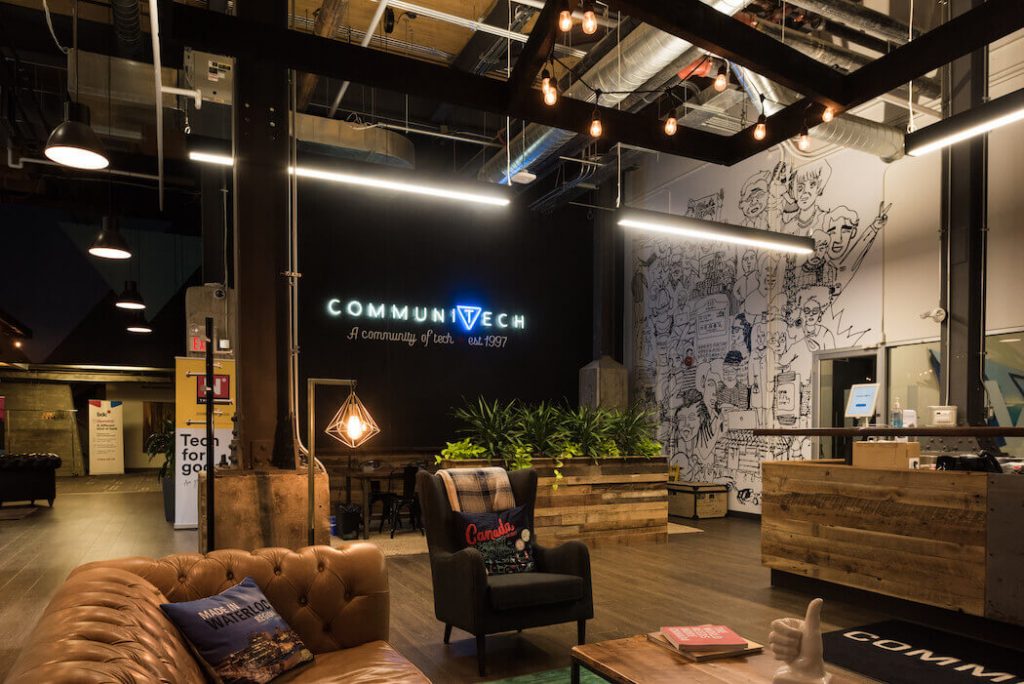Why Interac partnered with Communitech to bring its innovation lab to life

When large companies want to innovate and build an entrepreneurial culture, one of their first stops is to the local startup community. Whether it’s a partnership, acquisition, or simply collaborating, it’s clear that startups have a certain work style and energy that enterprises want to emulate.
“Our core function here at the Lab is to accelerate product development for Interac products and future initiatives.”
That energy is what Interac hoped to generate with its innovation lab. Launched in 2018 and based within the Kitchener-Waterloo tech hub, Communitech, the Interac Lab is focused on tackling market challenges to help develop propositions and features for Canadians. Specifically, the Lab is dedicated to the rapid prototyping and testing of novel ideas in the digital transaction space, including payments and digital ID.
Speaking with BetaKit, Interac Lab Director Tricia Gruetzmacher explained how Interac built its lab, how the lab team collaborates with Interac HQ, and how Communitech’s unique “innovation community” enables the company to embrace new ways of thinking while working alongside some of the best minds in tech, including scaling startups, other corporates, and local municipalities.
Back to the lab again
Interac designed its lab with a specific end goal: ensuring full integration into the existing Interac system. It would not be enough to have a lab that created new ideas that were thrown back to headquarters with no follow through. Instead, the Interac Lab’s founding team looks at the whole cycle of innovation, from ideation to implementation, to focus on where it could provide the most value.
“Our core function here at the Lab is to accelerate product development for Interac products and future initiatives that we’re working towards,” said Gruetzmacher.
A common challenge with innovation labs is that ideas can start hot but end up watered down by the time they get to HQ. This is usually the result of an HQ team that’s not included in the process, which Gruetzmacher said creates a situation where HQ may end up having issues with feasibility or other concerns.
Addressing feasibility and end-user needs is something Debbie Gamble, the Chief Officer of the Innovation Lab & New Ventures Team, constantly thinks about.
The Interac Lab has worked on multiple projects over the past year, including a solution to showcase future applications of Digital ID. “Digital ID is a big topic for us,” said Gamble. “Exploring how we can leverage our solutions to work with players in the ecosystem including public and private sector entities to empower Canadians by not only meeting their needs securely, but also giving them control over their information in a digital age is very important to us. Our Lab at Communitech helps us rapidly ideate potential scenarios to deliver the type of secure digital transaction experience Canadians expect from Interac.”

Image courtesy Interac
Interac planned around potential feasibility issues by including the HQ team in the ideation process, but the next challenge became HQ’s capacity to build and test the new ideas. That, said Gruetzmacher, is what the Interac Lab specializes in.
“We build something low fidelity [and] we test that out,” said Gruetzmacher, adding that the Interac Lab specializes in rapid prototyping, proof-of-concept building, and user research to gauge if its ideas have merit. “What we really look for there is – are we getting the right reaction? Are we on the right path? Are there any ‘gotchas’? And then how do we share that back [with HQ]? In this whole process, we’re engaging our stakeholders.”
To ensure the HQ team is included throughout the innovation process, teams from the Lab and HQ meet weekly during innovation sprints, which usually take four months. During the meetings, the Lab team identifies what to test or to build. The HQ team, on the other hand, adds in how the tests need to be built. For example, if it’s truly a low-fi proof-of-concept or if the rapid prototype needs to be written in a specific coding language to fit within Interac HQ’s product stack. At the end of the sprint, the Lab hands HQ its lessons and, if applicable, a built prototype that’s ready to fit into Interac HQ’s product development process.
“The biggest hurdle of opening any innovation lab is making sure that headquarters feels part of the journey,” said Gruetzmacher. “We do that by doing different projects with their product teams, bringing them here, and integrating them into our process.”
Communitech’s innovation-lab-as-a-service
Beyond challenges with communication and integration, there’s also the question of where you house the actual team. When it comes to outpost teams like innovation labs, some companies prefer physical separation and isolation. Others have the team housed within the main office so there’s more opportunity for collaboration. Interac took a different approach and leveraged Communitech’s ‘innovation-lab-as-a-service’ to build and house the Interac Lab.
Communitech helps Interac stay on top of who is building what and can make connections to local startups.
Communitech’s lab service launched to highlight how corporates could connect with startups, but the growth of the service means they can now network with government bodies and other corporations, too. Gruetzmacher said that in addition to the many corporate organizations, the Royal Canadian Air Force, the City of Kitchener, and the Government of Ontario all have labs housed at Communitech, offering unique networking and co-learning opportunities.
Collaborating daily with other members of the tech community helps Interac stay nimble, connected and agile as they create and test new use cases, says Gruetzmacher.
There’s also curated opportunities to connect with local startups. Gruetzmacher said that Communitech helps Interac stay on top of who is building what and can make connections to local startups working on problems that matter to corporate entities. The opportunity to join pitch competitions and other startup events hosted by Communitech “gives you more ecosystem to work with,” said Gruetzmacher.
Beyond offering space and networking opportunities with other labs, Communitech developed a full education-style service to help companies get through the finer details of running a successful lab. For example, Communitech facilitates education for all new hires in labs, including co-ops.
“Communitech offers, at the beginning of every term, a two-day [design thinking] course for the co-op [students],” said Gruetzmacher. “We sign each cluster up to that so they know what to expect and they learn the principles of design thinking.”

The Communitech entrance space, The Tannery Building, Kitchener-Waterloo. Source Communitech.
The design thinking course is just the beginning, as co-op students are fully integrated into Lab projects, which Dinaro Ly, Head of Innovation and Community Partnerships at Interac, said is great for people in engineering or data science.
For Ly, having co-ops at the Lab is about ensuring two things: that the company remains relevant, since it gets to engage with young people on emerging technology; and empowering the next generation with entrepreneurial skills, focused on building real solutions to big problems.
Building out this framework and support network, though, took support from HQ. As with any major initiative, stakeholder support can make or break an innovation lab project. But, as Interac knew from their own process designing the lab, integrating with HQ is a crucial step to make the wins at the lab matter to the whole organization. Communitech’s lab service also offers programs to help lab directors win the support of their stakeholders.
“They offer a program called the Leadership Compass to help leaders and executives get on board with what the innovation strategy should be for the company,” said Gruetzmacher.
Internal collaboration requires prioritization
Establishing ground rules to engage with the lab team’s capabilities and accessing that learning is critical to the success of a project. Organizations need to understand what projects a lab can and can’t take on. This understanding fundamentally comes from creating a solid foundation based on purpose and function.
For Gruetzmacher, the question is not about which product or service line the lab wants to work on. Instead, it’s about if the problem or opportunity is one that HQ is willing to prioritize and work on collaboratively. It also has to be a problem that would benefit from rapid prototyping or proof-of-concept building. If the idea is too vague or is one that HQ simply wants off its plate, Gruetzmacher recommends another avenue.
The question is “where can the lab really help create a [proof of concept] and get valuable input that accelerates the development or learnings we can have before you go to the full-scale market,” said Gruetzmacher. “That’s how we funnel it down.”
